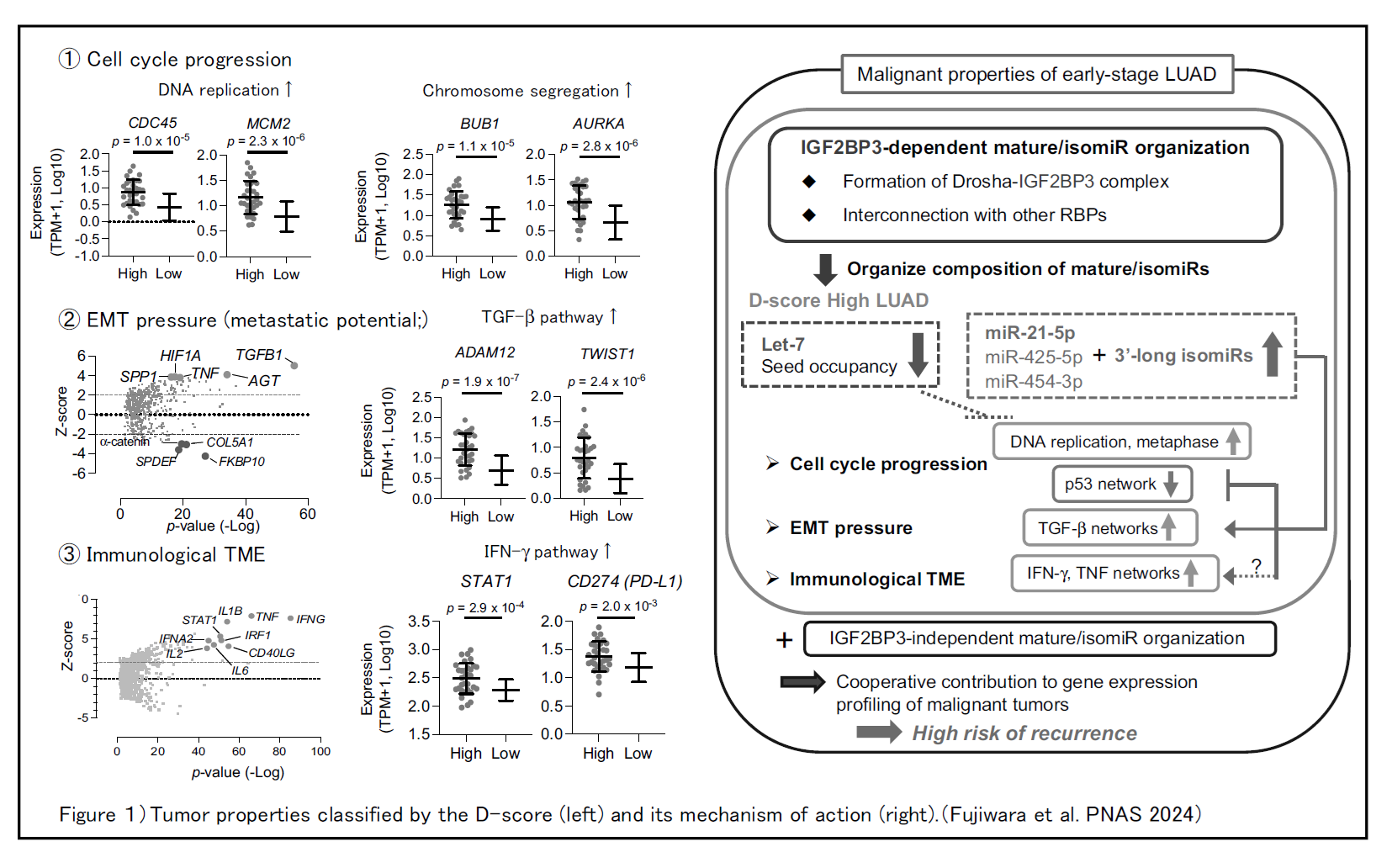Annual Report 2023
Laboratory of Molecular Carcinogenesis
Naoto Tsuchiya, Yuko Fujiwara, Masae Oomaru, Makiko Saito, Takahiro Shirai, Rumi Tanaka
Introduction
To understand the fundamental nature of cancer, it is essential to comprehend the network structures established within cancer cells. Our research unit is focused on elucidating the entire intracellular network formed in cancer cells, particularly through the analysis of microRNAs (miRNAs). We conduct foundational research across cellular, animal, and clinical sample analyses, aiming to support the development of innovative cancer therapies and diagnostic methods based on these insights.
Research Activities
(1) Understanding molecular basis of the control of microRNA structural diversity
This research unit aims to elucidate the comprehensive mechanisms of gene expression regulation mediated by miRNAs, focusing on uncovering the establishment processes of cancer-specific gene expression profiles. We also conduct foundational research to develop novel cancer therapies based on these principles. This year, we discovered that by scoring the predominance of specific miRNA structural isoforms, it is possible to stratify high-risk groups for early-stage non-small cell lung cancer recurrence with high sensitivity. The molecular background of this finding suggests that the predominance score enables assessment of critical malignant tumor characteristics, including high genetic mutability driven by cell cycle progression, epithelial-mesenchymal transition gene expression characteristics, and an immune-evasive microenvironment. Furthermore, we identified IGF2BP3, an oncofetal, multifunctional RNA-binding protein, as a regulatory factor within this system. Our findings reveal that IGF2BP3 is one of the factors controlling miRNA biogenesis, with expression in cancer cells organizing structural diversity within specific miRNA groups. Notably, miRNA structural isoforms influence the efficiency of target gene expression suppression. We report that this system contributes to the establishment of gene expression profiles that define cancerous malignant traits (Figure 1).
The findings of this study not only provide valuable insights for understanding cancer pathogenesis but also hold potential for clinical application. Notably, the predominance score, which enables recurrence prediction in early-stage lung cancer patients, demonstrates a high negative predictive value of 94%, potentially contributing to the reduction of overtreatment after surgery. To translate this principle into practical applications, we are conducting applied research in collaboration with industry partners.

(2) The role of miRNA secretion in the maintenance of malignant properties of cancer cells
Cancer cells secrete various factors to adapt to their surrounding microenvironment. miRNAs are released from cancer cells, often encapsulated in extracellular vesicles, and act to regulate nearby non-tumor cells, a process essential for maintaining the properties of tumor tissue. In parallel, it is thought that cancer cells maintain their malignant phenotype by inducing changes in their own gene expression profiles through the secretion of specific miRNAs. Our laboratory has identified that sarcoma cells under nutrient-poor conditions secrete specific miRNAs that may promote metastasis, suggesting that miRNA secretion contributes to determining the malignant phenotype of tumor cells. One intracellular target factor of these miRNAs, CMTM6, has been implicated in the intracellular recycling of immune-related molecules, such as PD-L1, though its additional functions remain largely unknown. We discovered that CMTM6 facilitates intracellular transport, mediating the transport of specific miRNAs and secretory factors. In particular, CMTM6 is associated with the intracellular transport of raft-associated proteins within the cell membrane, playing a crucial role in activating membrane receptor signaling while also uniquely regulating the secretion pathway of signaling molecules. Aiming for applications in cancer therapeutics, we are investigating nucleic acid delivery systems that target this molecule.
Education
We are supervising research and presentation skills for graduate students and young scientists.
Future Prospects
Based on this year’s findings, we expect to propose a new concept regarding miRNA functional abnormalities in carcinogenesis. Additionally, applying these principles could enable the development of a rapid and simple diagnostic method for identifying high-risk recurrence groups in early-stage lung adenocarcinoma. Given that this method strongly reflects tumor characteristics, it also holds potential as a biomarker to support treatment planning in personalized cancer medicine. Furthermore, this principle is expected to facilitate the development of cancer therapeutics with novel mechanisms of action. With intriguing insights into the significance of miRNA secretion to the extracellular environment, this study promises further advancements in our understanding of cancer pathogenesis.
